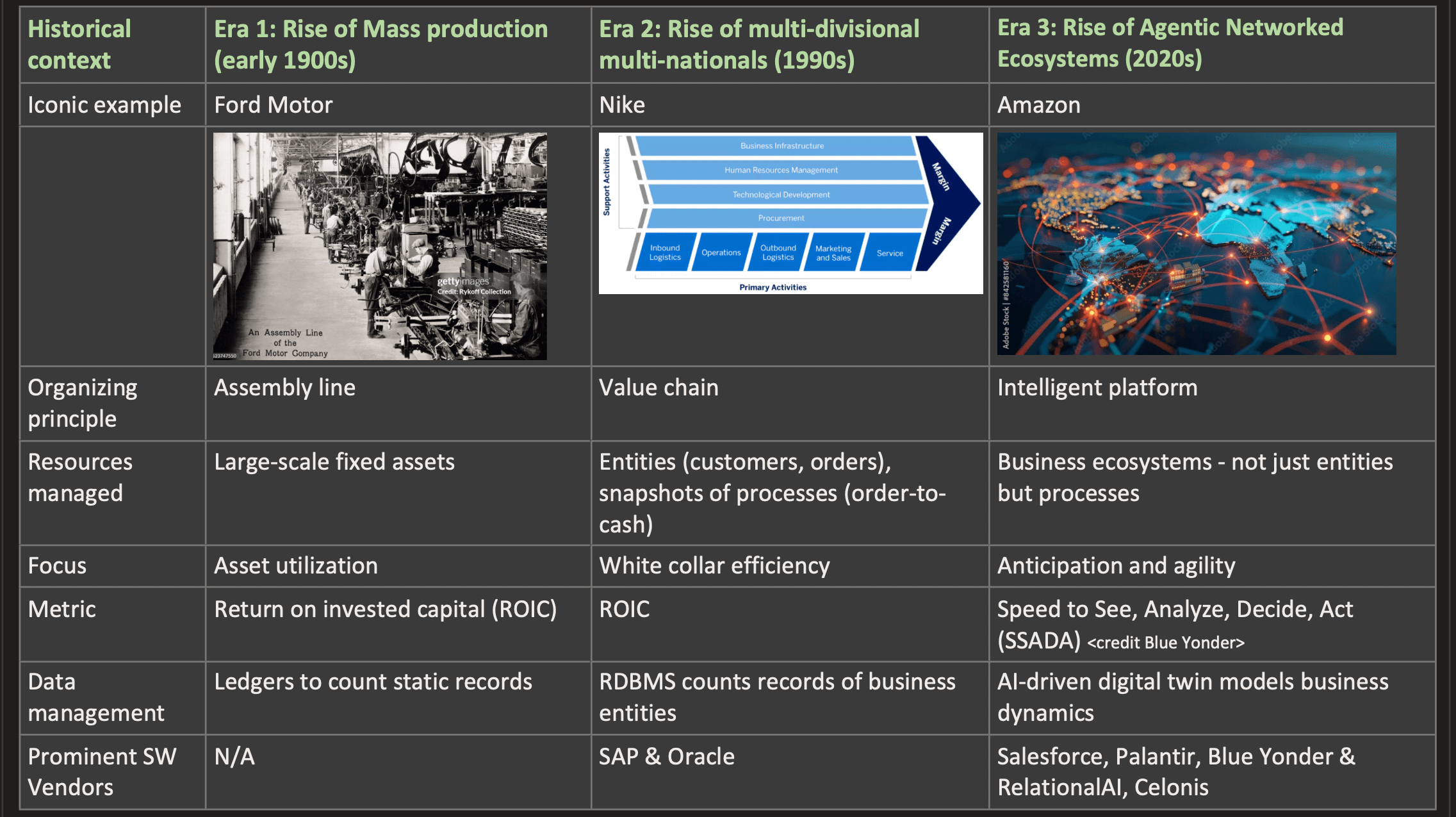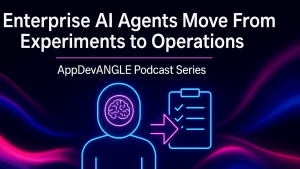
The Coming Transformation
Salesforce, Palantir, Celonis, and Blue Yonder/RelationalAI are spearheading a generational shift in how businesses create and deliver value and compete. We are witnessing the transition from an era where management was designed to operate static fixed assets (like assembly lines) for maximum efficiency to one where management resembles Amazon’s AI-driven platform—continuously learning, anticipating change, and rapidly realigning activities.
While this transformation might sound too futuristic to be immediately relevant, understanding this perspective can help frame today’s strategic choices and make achieving future outcomes more straightforward. To grasp why this change is happening and where we’re headed, we must first look backward.
Three Eras of Business Organization
| Historical context | Era 1: Rise of Mass production (early 1900s) | Era 2: Rise of multi-divisional multi-nationals (1990s) | Era 3: Rise of Agentic Networked Ecosystems (2020s) |
| Iconic example | Ford Motor | Nike | Amazon |
| Organizing principle | Assembly line | Value chain | Intelligent platform |
| Resources managed | Large-scale fixed assets | Entities (customers, orders), snapshots of processes (order-to-cash) | Business ecosystems – not just entities but processes |
| Focus | Asset utilization | White collar efficiency | Anticipation and agility |
| Metric | Return on invested capital (ROIC) | ROIC | Speed to See, Analyze, Decide, Act (SSADA) <credit Blue Yonder> |
| Data management | Ledgers to count static records | RDBMS counts records of business entities | AI-driven digital twin models business dynamics |
| Prominent SW Vendors | N/A | SAP & Oracle | Salesforce, Palantir, Blue Yonder & RelationalAI, Celonis |
Era 1: When Hierarchy Managed Information
Ford Motor’s River Rouge assembly line a century ago revolutionized manufacturing with mass production. The organization that grew around it relied on summarizing data from a relatively static set of activities. The goal was straightforward: squeeze ever more efficiency through better utilization of enormous fixed assets in the form of assembly lines. Better efficiency generated better returns on invested capital (ROIC), the ultimate measure of corporate performance.
Large hierarchical organizations became necessary to process information in this era. From the factory floor to executive offices, information flowed upward in increasingly summarized forms, with decisions flowing back down. This structure worked well for predictable environments where the primary challenge was optimizing known processes.
Era 2: When ERP Standardized Records of Business Entities
Nike exemplifies the globalization wave that accelerated in the 1990s. Multi-divisional multinationals leveraged enterprise applications like SAP built on relational database management systems (RDBMSs). Nike’s global success became possible because SAP running on Oracle transformed data into a corporate asset.
Just as the assembly line had standardized physical work, SAP standardized critical information flows throughout the organization. It created a universal language for counting entities such as customers and orders, and captured snapshots of processes like order-to-cash. This standardization enabled management to “see” across divisions and subsidiaries in different countries, driving unprecedented administrative efficiency.
However, these organizations were almost as static as the assembly lines of the previous era. While standardized processes made standard reports possible, the processes were entangled in procedural code, making them difficult to modify. Most large organizations eventually accumulated hundreds or thousands of applications, creating silos of data and automation. Each silo might integrate into the value chain of information, making individual work efficient, but the organization as a collection of silos couldn’t respond well to change.
Era 3: When AI Enables Learning Organizations
Amazon’s worldwide networked ecosystem exemplifies the emerging era of management and industrial organization. Rather than just managing static assets or data about business entities, management now orchestrates a global ecosystem of partners using information systems that are continuously learning.
The critical distinction is that this new approach goes beyond tracking data about snapshots of standardized processes. The processes themselves—the activities involving people and resources that create economic value—become critical assets in their own right.
The 4D Map: Making Business Processes Visible
Modern applications can store, analyze, and manipulate processes in a new generation of databases, much like RDBMSs stored 2D data about people and resources. Adding processes and how they interact over time as additional dimensions forms what we call a “4D map” in these databases—capturing what Palantir describes as the “kinetics and dynamics” of an enterprise.
Consider how this works in practice: While traditional ERP systems might record that an order was placed and then fulfilled, the 4D map captures the entire journey of that order—who touched it, what decisions were made, how resources were allocated, and how timing affected outcomes. This high-fidelity representation provides a foundation that analytics and AI agents need to operate more effectively. Physical robots need 4D perception to navigate the world. Agents need the same high-fidelity perception to operate effectively in the enterprise.
From Efficiency to Anticipation and Realignment
With such a detailed map of the business, advanced analytics and AI agents transform organizations. Rather than optimizing for efficiency alone, organizations can now optimize for speed in seeing, analyzing, deciding, and acting (SSADA) (credit to Blue Yonder for the SADA concept). What’s truly revolutionary is that AI can learn to anticipate external changes—such as shifts in customer demand—and then agents, with human supervision, can figure out how to realign resources and activities across functions and timeframes. Agents can now analyze and change the processes because they are no longer entangled in code. They are just like data assets stored in the new DBMS.
For example, Amazon doesn’t just react to customer orders; its systems anticipate demand patterns, pre-position inventory, and continuously improve based on interactions with human supervisors and feedback from operations. This represents a fundamental shift from reactive efficiency to proactive anticipation and agility.
The Vanguard of Business Transformation
Several key players are democratizing these capabilities:
- Salesforce’s Data Cloud differentiates the entire application suite and agents through its ability to capture the 4D process of a customer’s engagement journey rather than the traditional 2D snapshot of entities. This enables more personalized and anticipatory customer experiences. The 4D map enables the agents to perceive the state of the customer and then operationalize their decisions through the Customer 360 apps. Agents can reach the rest of the application estate via Mulesoft connectors.
- Blue Yonder is beginning to make Amazon-like capabilities more widely available, building on a 4D map enabled by RelationalAI’s relational knowledge graph database. This allows companies of various sizes to implement anticipatory supply chain management without Amazon’s resources.
- Celonis creates processes as assets by mining event logs from existing applications across the enterprise and abstracting that information into a coherent 4D map or knowledge graph. This allows organizations to discover inefficiencies and optimization opportunities without rebuilding their systems from scratch. Agents can use the 4D maps to see, analyze, decide, and act across heterogeneous systems.
- Palantir provides 4D platforms, which they refer to as digital twins, that capture the kinetics and dynamics of an enterprise. Their digital twin doesn’t just harmonize the analytic data. It harmonizes how to operationalize any actions the analytic decisons or agents need to take across the legacy application estate.
The Road Ahead
TheCUBE Research’s “Road to Service as Software (SaSo)” initiative aims to track how this new world is emerging. For 50 years, IT has enabled businesses to become more efficient. Now, management systems are beginning to “embody” the tacit knowledge and intelligence of managers themselves. This digital and human intelligence will start to convert management and the production of products and services into a new technology product some are already calling SaSo. Looking at Amazon and the enabling technology, we can see that it enables a scope and fidelity of management control never before possible.
We are likely to see “a collection of Amazons” that dominate major sectors of the economy, potentially displacing organizations that fail to make this transition. For executives making technology and strategy decisions today, understanding this trajectory isn’t just academic—it’s critical to ensuring their companies can participate in the intelligent, networked business ecosystems of tomorrow.



